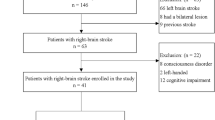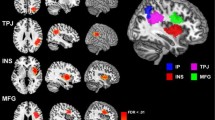Abstract
Current models of spatial neglect focus on deficits in the patients’ horizontal or midsagittal plane. However, other evidence suggests that patients with temporoparietal lesions centered on the parieto-insular-vestibular cortex show disturbed spatial perception of the subjective visual vertical and oblique orientation discrimination in another spatial plane, the frontal plane. As the relationship between neglect and spatial orientation deficits is unclear, we examined how patients with and without visual neglect perform visuospatial tasks in the roll plane and how their performance is related to neglect. Thirteen patients with predominantly right parietal lesions and left-sided neglect, 14 control patients without neglect after right-hemispheric cerebral lesions (RBD-controls), 11 patients without neglect after left-hemispheric lesions (LBD-controls), 3 patients with right-sided neglect after left parietal lesions, and 12 normal subjects were investigated. Constant errors and difference thresholds were measured with a PC-based system when the subjects had to adjust a luminous line to their subjective visual vertical, subjective visual horizontal, and in relation to an obliquely oriented reference line. Subjects were oriented with their head and body earth-vertical while sitting in a chair in total darkness. Patients with left-sided as well as those with right-sided neglect showed a significant, in most cases contraversive, tilt of the three spatial orientations (about 5° counterclockwise in the left neglect group and 5.5°–8.5° clockwise in the right neglect group). In contrast, the two patient groups without neglect as well as the normal subjects showed nearly perfect visuospatial judgements with constant errors of less than 0.8°. Difference thresholds were significantly elevated in patients with left neglect and in two of three patients with right-sided neglect, whereas normal control subjects and both control patient groups without neglect performed indistinguishably, having thresholds of one-tenth of those of the neglect patients. Tilt of all three spatial axes was significantly related to the severity of neglect (mean r for unsigned errors, 0.74; for difference thresholds, 0.40), indicating a significant contribution to the symptomatology of left and right spatial neglect. These results indicate a close although not necessarily causal link between spatial orientation deficits in the frontal plane and hemispatial neglect in patients with left or right parietal lesions, surpassing the well-documented impairments of these patients in the horizontal plane.
Similar content being viewed by others
Author information
Authors and Affiliations
Additional information
Received: 1 August 1997 / Accepted: 1 April 1998
Rights and permissions
About this article
Cite this article
Kerkhoff, G., Zoelch, C. Disorders of visuospatial orientation in the frontal plane in patients with visual neglect following right or left parietal lesions. Exp Brain Res 122, 108–120 (1998). https://doi.org/10.1007/s002210050497
Issue Date:
DOI: https://doi.org/10.1007/s002210050497




